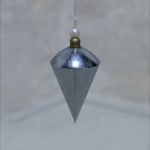

Bruna Esposito b. 1960
1 5/8 x 3 1/2 in
The work is a thread, a lead weight, and a white pearl. It is a pendant that the artist showed for the first time at the Venice Biennial Exhibition in 2005. It is thought to be the smallest work ever brought to the Biennial. 'Perla a piombo' is an 'object' which works on two levels. Its size and the precious, feminine pearl render it delicate, but the thread, the lead weight, and the lead prism - manual tools - place the work in a practical sphere. Bruna Esposito makes it possible for these two opposing forces to co-exist. The lead and the pearl are united by the same thread and, just like the conceptual work, it is linked to manual work. This binomial is recurrent for the artist who moves between the poetic impact of carefully chosen details and environments, and the feminine, ironic energy of a second reading. Bruna Esposito is in fact 'poetic' in the creation of works with common objects, for example, 'Panni Sporchi' (Dirty Laundry) (1993). In this work, the lighted candles turn a drying rack into a pleasing and ironic work. Esposito is also 'poetic' in the creation of contexts. Her interventions often come about in historical and symbolic settings like the former Tobacco Factory in Città Sant'Angelo where the artist intervenes (permanently) in 2003 for the exhibition 'Passiflora' (Passionflower). She also chooses urban or 'naturalized' settings: her series of benches become emblematic from the moment the artist chooses a common urban object, like a bench, and de-contextualizes it by placing it in a country setting, 'Acquarello' (Watercolour) (1988), or in a variety of different, sometimes shocking, contexts and elements that are typical of Esposito's works. One of her stronger and more provocative pieces was the performance 'Las agrada familia' in 1993: a black father and a white mother out for a walk with their child - a fish.
Exhibitions
2023 Madre Museum. Con questi chiari di luna2023 Art Monte-Carlo WIZARD GALLERY
2005 51° Biennale di Venezia

